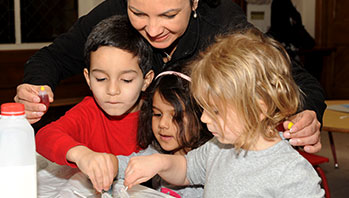- assortment of plant foods from the week
- bowls
- forks
- sprouts planted on Day 1
- leaf
- plant
- root
- sprout
- stem
MA Standards:
Speaking and Listening/SL.PK.MA.1: Participate in collaborative conversations with diverse partners during daily routines and play.
Head Start Outcomes:
Science Knowledge/Scientific Skills and Method: Collects, describes, and records information through discussions, drawings, maps, and charts.
Science Knowledge/Conceptual Knowledge of Natural and Physical Worlds: Observes, describes, and discusses living things and natural processes.
PreK Learning Guidelines:
English Language Arts/Language 2: Participate actively in discussions, listen to the ideas of others, and ask and answer relevant questions.
strong>Science and Technology/Inquiry Skills 4: Record observations and share ideas through simple forms of representation such as drawings.
Small Group: Sprout Salad

© Commonwealth of Massachusetts, Department of Early Education and Care (Jennifer Waddell photographer). All rights reserved.
STEM Key Concepts: There are many different types of plants; Many foods that animals, including humans, eat come from plants; We eat certain leaves, roots, fruits, and seeds
ELA Focus Skills: Listening and Speaking, Vocabulary
Tell each group that the sprouts are ready to eat, so they don’t have to rinse or chart the seeds any longer. Tell them they are going to make a sprout salad. Before children pick the sprouts, have them make some final observations on how the sprouts have changed. Ask,
- How have the sprouts changed since you first planted them?
- How do you know they are ready to eat?
Have children make one final drawing of the sprouts. Allow time for children to share the sequence of the seed growth in their drawings. Encourage children to use the words sprout and grew in their discussion.
Then have children pick the sprouts and combine them with other vegetables left over from the week’s explorations to make a salad. Before eating, have the children be “salad experts” and talk about the plants in their salads. Have them name the parts of plants (stem, leaves, roots) represented in the salad. Once the salad is ready have children shout “OLÉ!” and eat their salad.
Adaptation: For groups with young children, you may need to cut the vegetables into smaller pieces so they are easier for children to handle.
